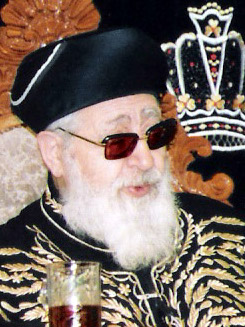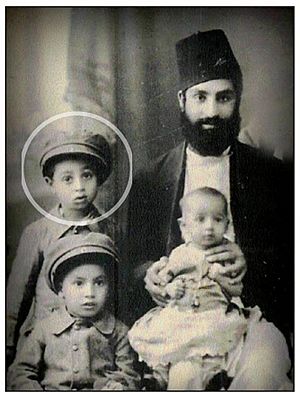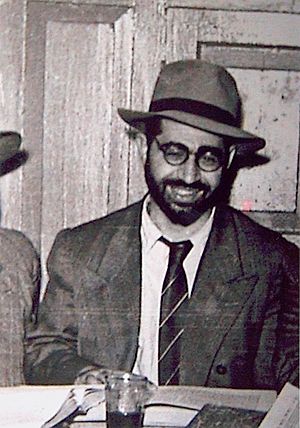Ovadia Yosef facts for kids
Quick facts for kids Ovadia Yosefעובדיה יוסף |
|
|---|---|

Rabbi Yosef in 2007
|
|
| Religion | Judaism |
| Denomination | Sephardi Haredi Judaism |
| Alma mater | Porat Yosef Yeshiva |
| Personal | |
| Nationality | Israeli |
| Born | ‘Abdullah Youssef September 24, 1920 Baghdad, Iraq |
| Died | October 7, 2013 (aged 93) Jerusalem |
| Spouse | Margalit Fattal |
| Children | 11, including Yitzhak Yosef, Ya'akov Yosef and Adina Bar-Shalom |
| Parents | Yaakov and Gorjiya Ovadia |
| Senior posting | |
| Predecessor | Yitzhak Nissim |
| Successor | Mordechai Eliyahu |
| Signature |  |
| Position | Sephardi Chief Rabbi of Israel |
| Organisation | Chief Rabbinate of Israel |
| Began | 1973 |
| Ended | 1983 |
| Other | Sephardi Chief Rabbi of Tel Aviv Spiritual leader of the Shas political party |
| Buried | Sanhedria Cemetery |
| Residence | Jerusalem |
| Semicha | Rabbi Ben Zion Hai Uziel |
Ovadia Yosef (Hebrew: עובדיה יוסף, romanized: Ovadya Yosef, Arabic: عبد الله יוסף, romanized: Abdullah Yusuf; September 24, 1920 – October 7, 2013) was a very important Jewish leader. He was born in Iraq and became a famous Talmudic scholar. From 1973 to 1983, he served as the Sephardi Chief Rabbi of Israel. He also helped start and lead the Shas political party in Israel for many years. Many people, especially from Mizrahi communities, saw him as a top authority on Jewish law.
Contents
Rabbi Ovadia Yosef's Life Story
Early Years and Education
Ovadia Yosef was born in Baghdad, Iraq, in 1920. His parents were Yaakov and Gorgia. When he was four years old, his family moved to Jerusalem, which was then called Mandatory Palestine. In Jerusalem, his family took the name "Ovadia." Later, Ovadia Yosef changed his last name to "Yosef" to avoid confusion.
His family was not wealthy. They lived in the Beit Yisrael neighborhood of Jerusalem. Young Ovadia had to work from a young age. He studied at the Talmud Torah B'nei Zion school. Even as a child, his talent for studying the Torah was clear. He started writing his own notes on Jewish texts when he was only nine years old.
In 1933, a wise rabbi named Hakham Sadqa Hussein encouraged Ovadia's father to send him to the Porat Yosef Yeshiva. There, he quickly became one of the best students. His teacher, Rabbi Ezra Attiya, was very important in helping him continue his studies. Once, when Ovadia stopped coming to school because he had to work, Rabbi Attiya went to his home. He even offered to work in Ovadia's father's grocery store so Ovadia could return to his studies. This shows how much his teacher believed in him.
Ovadia Yosef received his rabbinic ordination when he was 20. This meant he was officially recognized as a rabbi.
Time in Egypt
In 1947, Rabbi Yosef was invited to Cairo, Egypt. He taught at a yeshiva called 'Ahavah VeAchvah'. He also led the rabbinical court there. He noticed that many Jewish people in Egypt were not following religious laws very strictly. This caused some disagreements. After two years, he decided to leave his position and return to Israel.
Back in Israel
When he returned to Israel, Rabbi Yosef continued his studies. He also became a judge in a rabbinical court in Petah Tikva. He was very bold in his legal decisions, even at a young age.
In the early 1950s, he published his first book on Jewish law, called Hazon Ovadia. This book was highly praised by other important rabbis. A few years later, he started a yeshiva called 'Or HaTorah' for talented Sephardic students. He wanted to help more Sephardic Jews become leaders in their communities. He also published the first two parts of his major work, Yabia Omer.
From 1958 to 1965, Rabbi Yosef served as a rabbinical judge in Jerusalem. Later, he became the Chief Sephardic Rabbi of Tel Aviv in 1968.
Becoming Chief Rabbi of Israel
In 1973, Rabbi Ovadia Yosef was elected as the Sephardic Chief Rabbi of Israel. This was a very important position. He served in this role until 1983.
Starting a Political Party
In 1984, Rabbi Yosef founded the Shas political party. He did this because he felt that Sephardic Jews were not well represented in Israeli politics. Shas became a strong political force in Israel. Rabbi Yosef remained the spiritual leader of the party until his death.
Family Life
Rabbi Yosef married Margalit Fattal in 1944. They had eleven children together. Many of his children also became important figures in the Jewish community.
- Adina Bar-Shalom (born 1946) started the first college for Haredi women in Jerusalem.
- Ya'akov Yosef (1947–2013) was a rabbi and a politician who served in the Israeli parliament.
- Avraham Yosef (born 1949) is the Chief Rabbi of Holon, Israel.
- Yitzhak Yosef (born 1952) is currently the Sephardi Chief Rabbi of Israel, following in his father's footsteps. He also wrote a popular series of books on Jewish law.
- David Yosef (born 1960) is a well-known rabbi and leader in Jerusalem.
- Moshe Yosef (born 1966) is also a rabbi and manages his father's publishing house.
Later Years and Passing
Rabbi Yosef lived in the Har Nof neighborhood of Jerusalem. He continued to be an active public figure. He gave weekly sermons and was seen as a spiritual guide for many. People often called him "Posek HaDor" (the decider of Jewish law for the generation) or "Gadol HaDor" (the great one of the generation).
He passed away on October 7, 2013. His funeral in Jerusalem was one of the largest gatherings in Israel's history, with hundreds of thousands of people attending. He was buried next to his wife in the Sanhedria Cemetery. His grave quickly became a place where many people would visit to pay their respects.
Rabbi Yosef's Approach to Jewish Law
Bringing Back Old Traditions
Rabbi Yosef often used the phrase "Restore past glory." This meant he wanted to bring back the honor and traditions of Mizrahi Jews in Israeli society. He also wanted to emphasize the importance of the rulings of Rabbi Yosef Karo, a very important Jewish legal scholar from centuries ago. Rabbi Yosef believed that all Jews in Israel should follow Rabbi Karo's rulings.
Preferring Leniency
One of Rabbi Yosef's main beliefs was that it's often better to make lenient (less strict) rulings in Jewish law. He felt that being too strict might make it harder for people to follow Jewish law at all. He believed that the Sephardic way of making decisions often preferred leniency.
Here are some examples of his more lenient rulings:
- He allowed boys and girls to study together until age nine.
- He said that married women covering their hair could show a small amount of hair from the front.
- He allowed unmarried women to wear their hair loose.
He wanted to help as many Israelis as possible observe Jewish traditions. He was willing to make rulings that helped people follow the law, even if it meant being less strict in some areas.
Valuing Deep Study
Rabbi Yosef believed that studying Jewish law in depth was very important. He thought that focusing on practical Jewish law helped rabbis make better decisions for modern issues. He felt that some other approaches to study, which focused more on complex theoretical debates, could lead to rabbis being too strict because they didn't know all the different lenient opinions from the past.
Views on Israel and Its People
Ethiopian Jews
Rabbi Ovadia Yosef played a key role in helping Ethiopian Jews come to Israel. In the 1970s, he ruled that Ethiopian Jews were indeed Jewish according to Jewish law. He actively supported their immigration to Israel. Many people from the Ethiopian Jewish community are very grateful for his efforts.
Relationship with the State of Israel
Rabbi Yosef had a complex view of Zionism and the State of Israel. He saw Israel as a significant step towards redemption. His position was often a middle ground between different religious groups in Israel.
In 2010, the Shas party, under his guidance, joined the World Zionist Organization. This was a notable step, making Shas the first officially Zionist Haredi party in Israel.
Yeshiva Students and Military Service
Rabbi Yosef believed that the wars fought by Israel were important. However, he encouraged young religious students to continue their studies in yeshivas rather than join the military. He felt that their Torah study was also a vital contribution to the Jewish people. Despite this, he had a positive view of the Israel Defense Forces (IDF) and would often bless IDF soldiers. His own son, Rabbi Avraham Yosef, served as a military rabbi for 13 years.
Secular Israelis
Rabbi Yosef understood that many Israelis were not fully observant of Jewish law. He wanted to bring these people closer to the Torah. He ruled that even those who did not observe the Sabbath were still considered Jewish. This was a more accepting view than some other religious leaders held. He actively tried to connect with and inspire non-observant Jews.
Peace and Conflict
Rabbi Yosef was a strong supporter of peace negotiations in the Israeli–Palestinian conflict. He believed that saving lives (a principle called Pikuach Nefesh in Jewish law) was the most important thing. He argued that if peace talks could save lives, then Israel should pursue them, even if it meant giving up some land. He first used this idea in 1979, supporting the return of the Sinai Peninsula to Egypt for peace.
He instructed the Shas party to join governments that pursued peace agreements. However, when peace efforts stalled and violence increased, he sometimes changed his stance, supporting more cautious approaches. He always maintained that saving lives was the top priority in these conflicts.
Important Legal Rulings
Rabbi Ovadia Yosef is considered one of the most important authorities on Jewish law, especially for Sephardi and Mizrahi Jews. He was given the special title "Maran," meaning "our master."
Some of his well-known legal decisions include:
- In 1973, he ruled that the Ethiopian Beta Israel community were Jewish. This decision helped them immigrate to Israel.
- He supported the idea that Israel could give up land for a true peace.
- He allowed the wives of soldiers missing in action for a long time to remarry. This was a very important ruling for these women.
- He ruled that married women should cover their hair with headscarves, hats, or snoods, rather than wigs.
Published Works
Rabbi Yosef wrote many important books on Jewish law. One of his early works was Halikhot Olam. He also helped finish a commentary called Kaf Ha'Chaim.
His most famous collections of legal rulings are Yabia Omer and Yechaveh Da'at. These books are known for citing almost every source related to a topic. He also wrote a series of books called Hazon Ovadia about the laws of Shabbat and holidays.
In 1970, Rabbi Yosef received the Israel Prize for Rabbinical literature, which is one of Israel's highest honors. His sons have also published books based on his rulings, making his teachings widely available.
Images for kids
See also
 In Spanish: Ovadia Yosef para niños
In Spanish: Ovadia Yosef para niños
- Moetzet Chachmei HaTorah, the Sephardic Haredim Council of wise Torah Sages
- Avraham Yosef
- Yaakov Yosef
- Salah Hamouri
| Preceded by Yitzhak Nissim |
Sephardi Chief Rabbi of Israel Ovadia Yosef 1973–1983 |
Succeeded by Mordechai Eliyahu |




